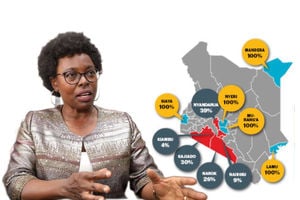
County and public officials have continued to spend way money on travel than is allowed by law.
On October 30, last year, two large delegations from Kitui County Assembly flew to Singapore to attend workshops.
The 12 MCAs and two assembly employees collectively spent over Sh22 million, which meant each official pocketed over Sh1.5 million, for the five-day junket.
Their choice of destination results in generous travel perks. Singapore fetches the highest daily allowance for globe-trotting Kenyan public officers, which range between $366 for a junior civil servant to $1,297 for a top State officer, according to a Salaries Remuneration Commission’s circular.
Also Read: Controller of Budget report sparks alarms over salaries and travel splurge by county governments
This is the reason Singapore—a high-income economy with a gross national income of US$82,807 per capita as of 2022, nearly 40 times Kenya’s $2,099—is a popular destination for Kenyan delegations.
One group of six Kitui MCAs and one assembly employee that travelled to Singapore from October 30 to November 3 last year, attended a workshop on agriculture. On the same dates, the other delegation of six MCAs and one staff travelled to the island in Southeast Asia for a workshop on scrutinising public expenditure.
Each of the delegations spent over Sh11 million during the tour, even as a national government ban on non-essential travel imposed on October, last year, was in force.
Earlier, from August 14 to 18, 2023, three officers from the Bomet County executive had spent Sh2 million in Singapore where they attended an audit workshop.
Between October 31 and November 9 last year, one official of Kericho County Assembly pocketed Sh3.1 million to attend a performance management course in the United Kingdom.
From December 10 to 16, last year, eight officials from the Kericho County Assembly spent Sh9.6 million—Sh1.2 million each—to travel to Dubai for a culture conference. Earlier, on July 17 and 28, the assembly had paid two officers Sh2.6 million to attend a rotary convention in Australia.
From July 19 to 26, an officer of the Elgeyo-Marakwet County Assembly pocketed Sh1.6 million for training on building smart cities in Dubai.
Five officers of Busia county executive splashed Sh5.3 million on an industrial park benchmarking tour of Ethiopia on August 22, 2023.
These are among the highest expenditures on foreign travel by county officials for the six months to December 31, last year that have been flagged by the Controller of Budget.
Some of these counties that lavished officials with generous travel perks failed to meet their revenue collection targets by wide margins.
Even worse, these counties spent more on fat travel allowances than the revenue they generated, according to an analysis of the report released last month by Controller of Budget Margaret Nyakang’o.

Controller of Budget Margaret Nyakang’o.
Kericho (12.7 per cent), Kilifi (10.5 per cent) and Machakos (7.4 per cent) are the counties that reported the lowest performance in own-source revenue collections against their annual targets.
Yet, the three counties were among those that spent more on travel perks than their incomes, according to the county governments’ budget implementation review report for the first half of 2023/24 financial, ending December 31, 2023.
Kericho splashed Sh257 million on local and international travel while it only generated Sh161 million in revenue. Machakos also spent more on travel (Sh393 million) than the revenue collected (Sh295 million).
Kilifi splashed Sh121 million on travel, which was almost equivalent to the amount it collected in revenue (Sh122 million).
Other counties that spent more on travel than revenue collected were Bomet, Busia, Kitui, Mandera, Marsabit, Migori, Nandi, Nyamira, Tana River, Turkana, Wajir and West Pokot
Although Bomet only managed to raise Sh67.7 million in revenue, the county executive and assembly splashed Sh128 million on foreign and local travel.
Kitui lavished its officials with Sh323 million travel perks yet it only collected Sh70 million in own revenue.
Marsabit officials spent Sh138 million on local and foreign travel although the county government only collected Sh60 million in revenues.
Also Read: Exposed - The burden of ‘budgeted graft’
During the review period, Migori spent Sh297 million on travel perks but only raised Sh187 million in revenues. Nandi spent Sh204 million on travel compared to Sh136 million collected in revenue.
Officials in Tana River only mobilised a paltry Sh30 million in income but splashed Sh160 million on travel. Turkana officials awarded themselves Sh335 million in travel allowances although the county raised Sh106 million revenue.
Wajir officials spent Sh127 million in local and international travel yet the county only collected Sh49 million in revenue. It was the same case in West Pokot which only collected Sh24 million in revenue but spent Sh81 million in travel.
Collectively, the counties spent Sh7.7 billion on local and foreign travel while the total revenue generated was Sh20.5 billion during the period under review.
It means the devolved units splashed an equivalent of more than one-third of the total revenue they generated on travel, which flew in the face of austerity measures.
Also Read: Here are Kenya’s ‘most corrupt’ counties
An October 2, 2023 circular had directed the National Treasury to reduce by half all foreign and local travel budgets, banned non-essential foreign tours as well as limited the size of Kenyan delegations.
Addressed to all senior government officials, including Cabinet Secretaries, Principal Secretaries, governors, clerks of Parliament as well as county assemblies, the directive by Chief of Staff and Head of Public Service Felix Koskei cited the need to ensure prudent spending of public money.
But the government’s travel budget nearly doubled within three months of the ban imposed to reduce wastage as globetrotting public officials ignored austerity measures.
Dr Nyakang’o has criticised counties for the persistent under-performance in own-source revenue collection.
During the reporting period, county governments generated Sh19.95 billion, which was 24.9 per cent of the annual target of Sh80.20 billion.
This was far much less than the expected performance of 50 per cent of the annual target (Sh40 billion) in the first half of 2023/24 financial year.
The CoB noted that there was over-reliance on the health sector as the main source of revenue, which was Sh6.4 billion or 32.1 per cent of the total realised own-source revenue. Many counties depended on health funds to prop up their revenues. These included Elgeyo Marakwet (79.6 per cent), Homa Bay (78 per cent) and Siaya (75.7 per cent).
Article 209 (3) of the Constitution allows county governments to impose property rates, entertainment taxes and any other tax that a county is authorised to charge by an Act of Parliament.
Only five counties achieved the 50 per cent target—Samburu (55.7 per cent), Elgeyo-Marakwet (56.3 per cent), Isiolo (62 per cent), Narok (63.9 per cent) and Nyeri (71.4 per cent).
“The underperformance of own-source revenue collection implies that the counties could not implement some planned activities due to budget deficits,” the CoB’s report observes.
Yet despite these limited resources, counties continue to spend the most on personnel emoluments—wages and allowances—even violating the statutory ceiling set at 35 per cent of the county’s total revenue.
Overall, county governments spent Sh98.13 billion on personnel emoluments, which accounted for 58.2 per cent of the total expenditure and 47.8 per cent of the realised revenue in the first half of 2023/24 financial year.
Also Read:Ruto insiders bag mega contracts
This includes Sh703.62 million that county assemblies cumulatively spent on MCAs’ sitting allowances, much more than the Sh434.29 million spent in a similar period the previous year.
Further, the analysis of the wage bill shows that Sh7.06 billion of the payrolls were processed manually and outside the government payroll system.
“This contradicts the government policy that requires salaries to be processed through the IPPD system. The manual payroll is prone to abuse and may lead to the loss of public funds where there is a lack of proper controls,” the report cautions.
The runaway expense on salaries and allowances has left little resources for development.
While Sh143.72 billion was spent on recurrent expenditure, only Sh24.81 billion went towards development during the six months under review.
The development expenditure represented 14.7 per cent of the total expenditure, which meant county governments did not achieve the statutory minimum expenditure of 30 per cent.












